Legal Reporting Requirements
VerifiedAdded on 2023/03/31
|8
|1429
|315
AI Summary
This article discusses the legal requirements of mandatory reporting in the United States, with a focus on child abuse. It covers the procedures, documentation, and consequences of reporting, as well as the law and legislation categories. The article is relevant for health professionals and caregivers who are mandated reporters.
Contribute Materials
Your contribution can guide someone’s learning journey. Share your
documents today.
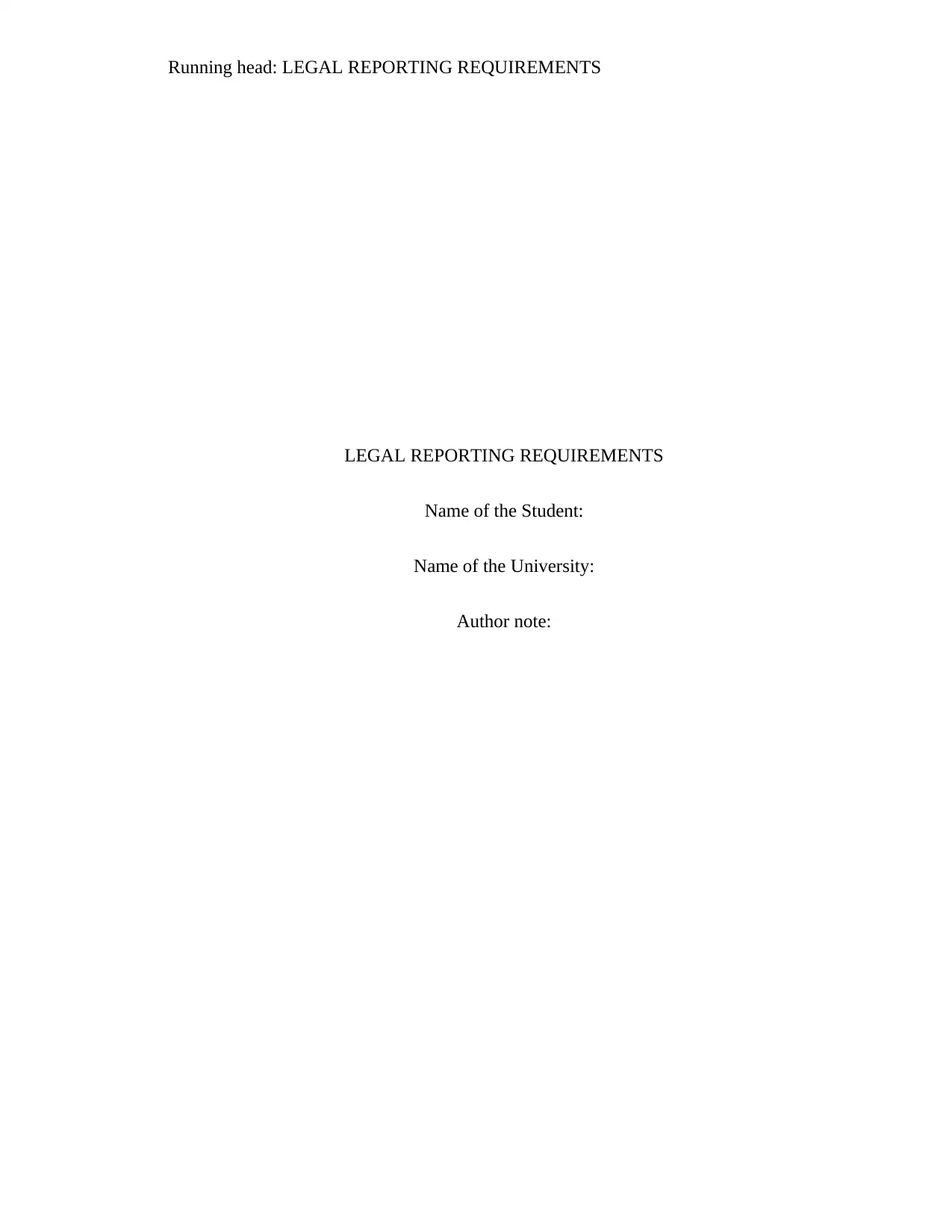
Running head: LEGAL REPORTING REQUIREMENTS
LEGAL REPORTING REQUIREMENTS
Name of the Student:
Name of the University:
Author note:
LEGAL REPORTING REQUIREMENTS
Name of the Student:
Name of the University:
Author note:
Secure Best Marks with AI Grader
Need help grading? Try our AI Grader for instant feedback on your assignments.
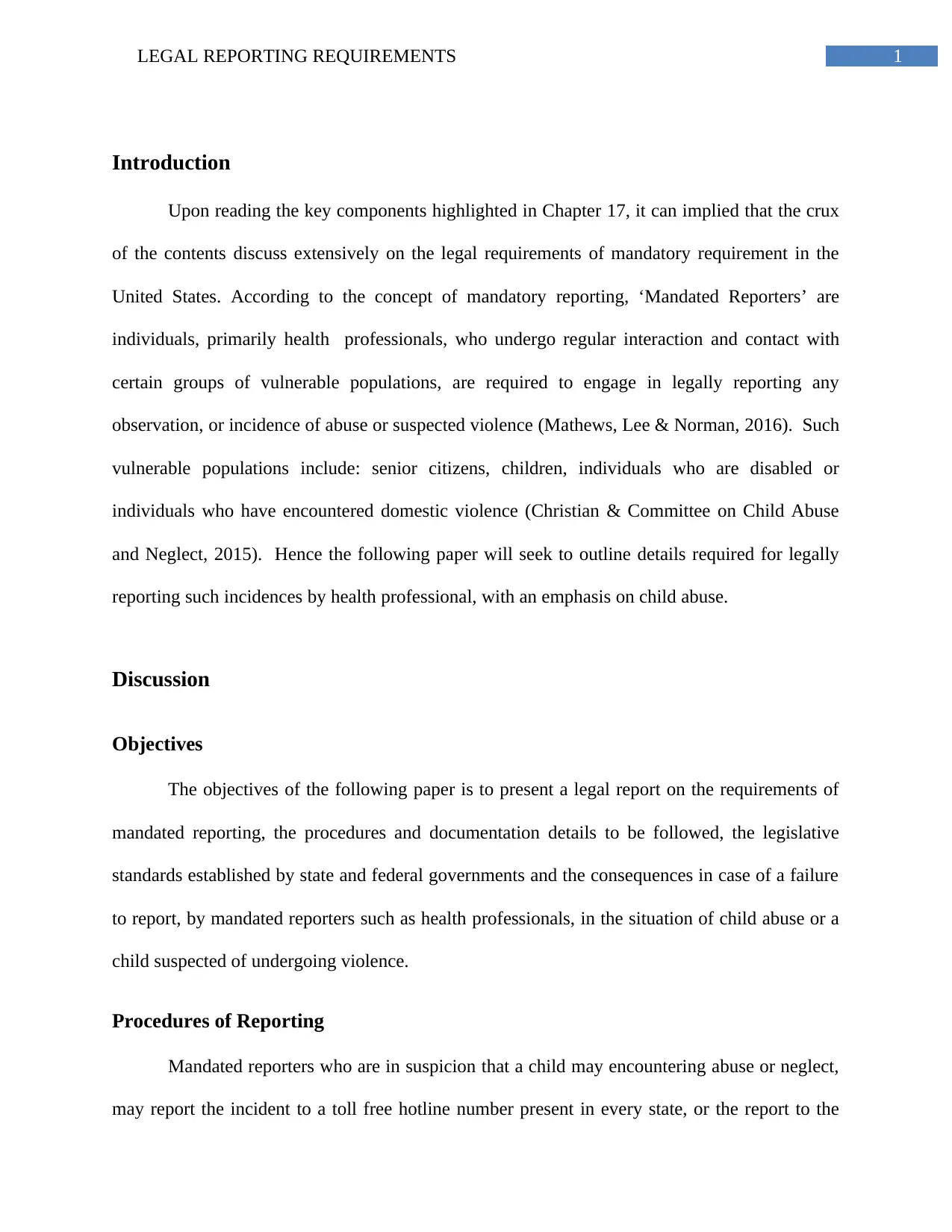
1LEGAL REPORTING REQUIREMENTS
Introduction
Upon reading the key components highlighted in Chapter 17, it can implied that the crux
of the contents discuss extensively on the legal requirements of mandatory requirement in the
United States. According to the concept of mandatory reporting, ‘Mandated Reporters’ are
individuals, primarily health professionals, who undergo regular interaction and contact with
certain groups of vulnerable populations, are required to engage in legally reporting any
observation, or incidence of abuse or suspected violence (Mathews, Lee & Norman, 2016). Such
vulnerable populations include: senior citizens, children, individuals who are disabled or
individuals who have encountered domestic violence (Christian & Committee on Child Abuse
and Neglect, 2015). Hence the following paper will seek to outline details required for legally
reporting such incidences by health professional, with an emphasis on child abuse.
Discussion
Objectives
The objectives of the following paper is to present a legal report on the requirements of
mandated reporting, the procedures and documentation details to be followed, the legislative
standards established by state and federal governments and the consequences in case of a failure
to report, by mandated reporters such as health professionals, in the situation of child abuse or a
child suspected of undergoing violence.
Procedures of Reporting
Mandated reporters who are in suspicion that a child may encountering abuse or neglect,
may report the incident to a toll free hotline number present in every state, or the report to the
Introduction
Upon reading the key components highlighted in Chapter 17, it can implied that the crux
of the contents discuss extensively on the legal requirements of mandatory requirement in the
United States. According to the concept of mandatory reporting, ‘Mandated Reporters’ are
individuals, primarily health professionals, who undergo regular interaction and contact with
certain groups of vulnerable populations, are required to engage in legally reporting any
observation, or incidence of abuse or suspected violence (Mathews, Lee & Norman, 2016). Such
vulnerable populations include: senior citizens, children, individuals who are disabled or
individuals who have encountered domestic violence (Christian & Committee on Child Abuse
and Neglect, 2015). Hence the following paper will seek to outline details required for legally
reporting such incidences by health professional, with an emphasis on child abuse.
Discussion
Objectives
The objectives of the following paper is to present a legal report on the requirements of
mandated reporting, the procedures and documentation details to be followed, the legislative
standards established by state and federal governments and the consequences in case of a failure
to report, by mandated reporters such as health professionals, in the situation of child abuse or a
child suspected of undergoing violence.
Procedures of Reporting
Mandated reporters who are in suspicion that a child may encountering abuse or neglect,
may report the incident to a toll free hotline number present in every state, or the report to the
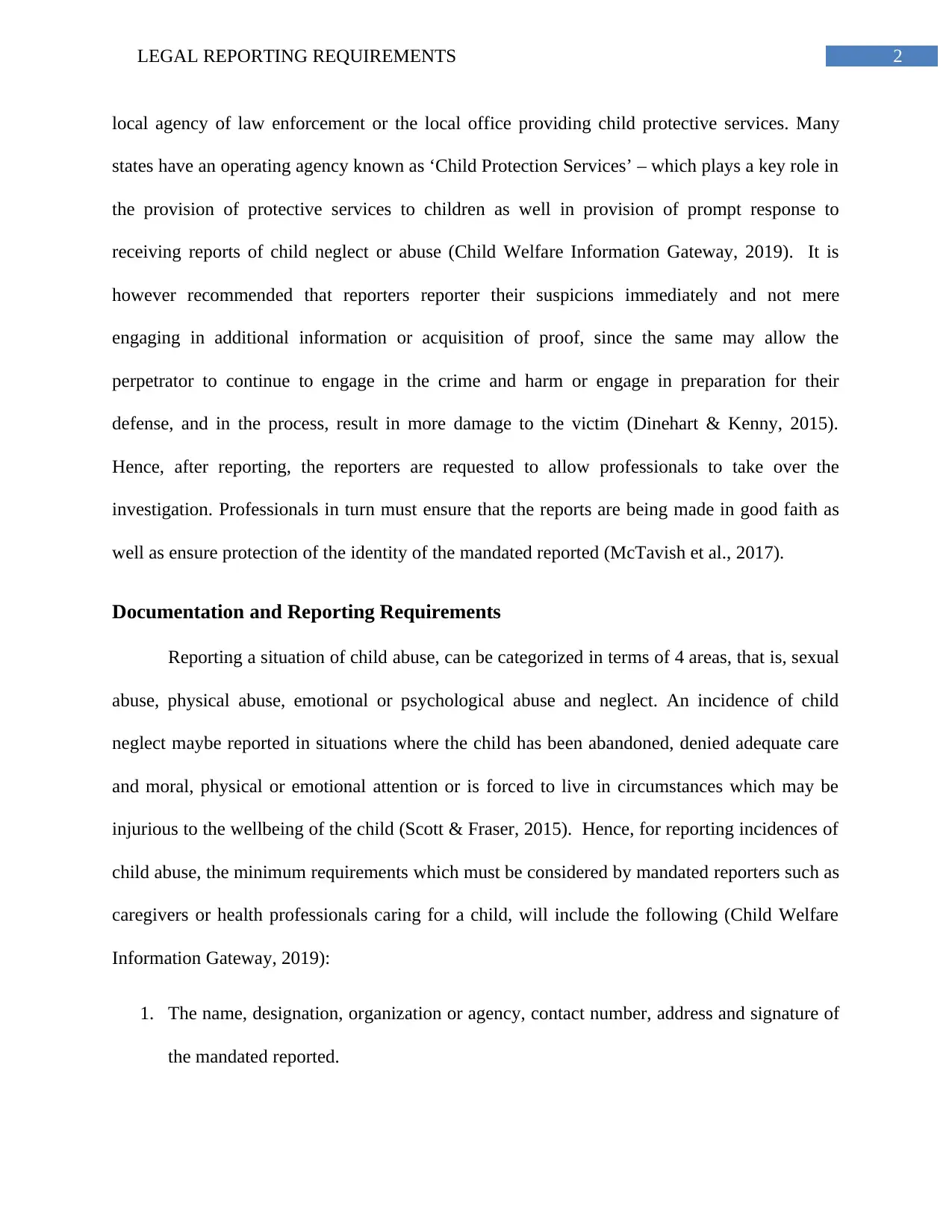
2LEGAL REPORTING REQUIREMENTS
local agency of law enforcement or the local office providing child protective services. Many
states have an operating agency known as ‘Child Protection Services’ – which plays a key role in
the provision of protective services to children as well in provision of prompt response to
receiving reports of child neglect or abuse (Child Welfare Information Gateway, 2019). It is
however recommended that reporters reporter their suspicions immediately and not mere
engaging in additional information or acquisition of proof, since the same may allow the
perpetrator to continue to engage in the crime and harm or engage in preparation for their
defense, and in the process, result in more damage to the victim (Dinehart & Kenny, 2015).
Hence, after reporting, the reporters are requested to allow professionals to take over the
investigation. Professionals in turn must ensure that the reports are being made in good faith as
well as ensure protection of the identity of the mandated reported (McTavish et al., 2017).
Documentation and Reporting Requirements
Reporting a situation of child abuse, can be categorized in terms of 4 areas, that is, sexual
abuse, physical abuse, emotional or psychological abuse and neglect. An incidence of child
neglect maybe reported in situations where the child has been abandoned, denied adequate care
and moral, physical or emotional attention or is forced to live in circumstances which may be
injurious to the wellbeing of the child (Scott & Fraser, 2015). Hence, for reporting incidences of
child abuse, the minimum requirements which must be considered by mandated reporters such as
caregivers or health professionals caring for a child, will include the following (Child Welfare
Information Gateway, 2019):
1. The name, designation, organization or agency, contact number, address and signature of
the mandated reported.
local agency of law enforcement or the local office providing child protective services. Many
states have an operating agency known as ‘Child Protection Services’ – which plays a key role in
the provision of protective services to children as well in provision of prompt response to
receiving reports of child neglect or abuse (Child Welfare Information Gateway, 2019). It is
however recommended that reporters reporter their suspicions immediately and not mere
engaging in additional information or acquisition of proof, since the same may allow the
perpetrator to continue to engage in the crime and harm or engage in preparation for their
defense, and in the process, result in more damage to the victim (Dinehart & Kenny, 2015).
Hence, after reporting, the reporters are requested to allow professionals to take over the
investigation. Professionals in turn must ensure that the reports are being made in good faith as
well as ensure protection of the identity of the mandated reported (McTavish et al., 2017).
Documentation and Reporting Requirements
Reporting a situation of child abuse, can be categorized in terms of 4 areas, that is, sexual
abuse, physical abuse, emotional or psychological abuse and neglect. An incidence of child
neglect maybe reported in situations where the child has been abandoned, denied adequate care
and moral, physical or emotional attention or is forced to live in circumstances which may be
injurious to the wellbeing of the child (Scott & Fraser, 2015). Hence, for reporting incidences of
child abuse, the minimum requirements which must be considered by mandated reporters such as
caregivers or health professionals caring for a child, will include the following (Child Welfare
Information Gateway, 2019):
1. The name, designation, organization or agency, contact number, address and signature of
the mandated reported.
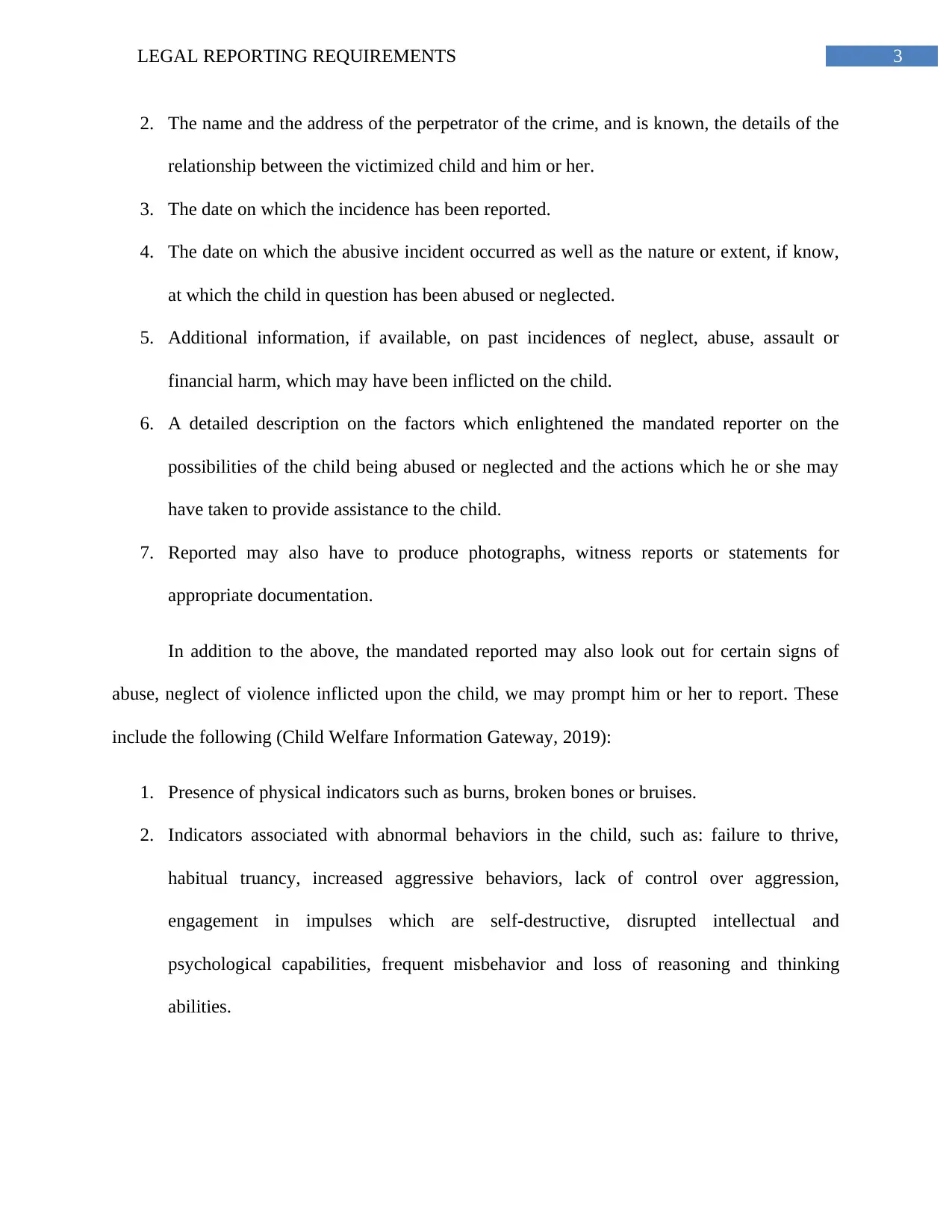
3LEGAL REPORTING REQUIREMENTS
2. The name and the address of the perpetrator of the crime, and is known, the details of the
relationship between the victimized child and him or her.
3. The date on which the incidence has been reported.
4. The date on which the abusive incident occurred as well as the nature or extent, if know,
at which the child in question has been abused or neglected.
5. Additional information, if available, on past incidences of neglect, abuse, assault or
financial harm, which may have been inflicted on the child.
6. A detailed description on the factors which enlightened the mandated reporter on the
possibilities of the child being abused or neglected and the actions which he or she may
have taken to provide assistance to the child.
7. Reported may also have to produce photographs, witness reports or statements for
appropriate documentation.
In addition to the above, the mandated reported may also look out for certain signs of
abuse, neglect of violence inflicted upon the child, we may prompt him or her to report. These
include the following (Child Welfare Information Gateway, 2019):
1. Presence of physical indicators such as burns, broken bones or bruises.
2. Indicators associated with abnormal behaviors in the child, such as: failure to thrive,
habitual truancy, increased aggressive behaviors, lack of control over aggression,
engagement in impulses which are self-destructive, disrupted intellectual and
psychological capabilities, frequent misbehavior and loss of reasoning and thinking
abilities.
2. The name and the address of the perpetrator of the crime, and is known, the details of the
relationship between the victimized child and him or her.
3. The date on which the incidence has been reported.
4. The date on which the abusive incident occurred as well as the nature or extent, if know,
at which the child in question has been abused or neglected.
5. Additional information, if available, on past incidences of neglect, abuse, assault or
financial harm, which may have been inflicted on the child.
6. A detailed description on the factors which enlightened the mandated reporter on the
possibilities of the child being abused or neglected and the actions which he or she may
have taken to provide assistance to the child.
7. Reported may also have to produce photographs, witness reports or statements for
appropriate documentation.
In addition to the above, the mandated reported may also look out for certain signs of
abuse, neglect of violence inflicted upon the child, we may prompt him or her to report. These
include the following (Child Welfare Information Gateway, 2019):
1. Presence of physical indicators such as burns, broken bones or bruises.
2. Indicators associated with abnormal behaviors in the child, such as: failure to thrive,
habitual truancy, increased aggressive behaviors, lack of control over aggression,
engagement in impulses which are self-destructive, disrupted intellectual and
psychological capabilities, frequent misbehavior and loss of reasoning and thinking
abilities.
Secure Best Marks with AI Grader
Need help grading? Try our AI Grader for instant feedback on your assignments.
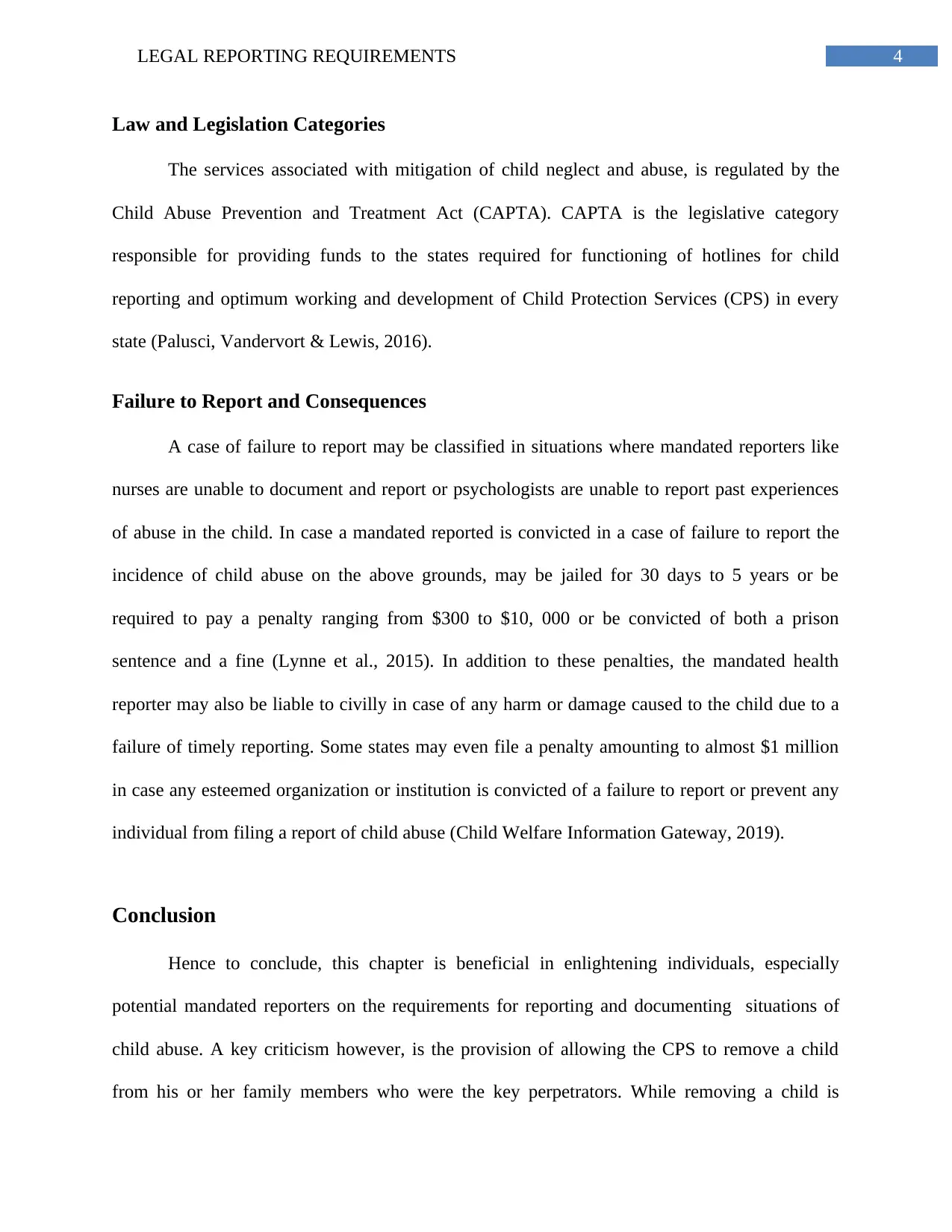
4LEGAL REPORTING REQUIREMENTS
Law and Legislation Categories
The services associated with mitigation of child neglect and abuse, is regulated by the
Child Abuse Prevention and Treatment Act (CAPTA). CAPTA is the legislative category
responsible for providing funds to the states required for functioning of hotlines for child
reporting and optimum working and development of Child Protection Services (CPS) in every
state (Palusci, Vandervort & Lewis, 2016).
Failure to Report and Consequences
A case of failure to report may be classified in situations where mandated reporters like
nurses are unable to document and report or psychologists are unable to report past experiences
of abuse in the child. In case a mandated reported is convicted in a case of failure to report the
incidence of child abuse on the above grounds, may be jailed for 30 days to 5 years or be
required to pay a penalty ranging from $300 to $10, 000 or be convicted of both a prison
sentence and a fine (Lynne et al., 2015). In addition to these penalties, the mandated health
reporter may also be liable to civilly in case of any harm or damage caused to the child due to a
failure of timely reporting. Some states may even file a penalty amounting to almost $1 million
in case any esteemed organization or institution is convicted of a failure to report or prevent any
individual from filing a report of child abuse (Child Welfare Information Gateway, 2019).
Conclusion
Hence to conclude, this chapter is beneficial in enlightening individuals, especially
potential mandated reporters on the requirements for reporting and documenting situations of
child abuse. A key criticism however, is the provision of allowing the CPS to remove a child
from his or her family members who were the key perpetrators. While removing a child is
Law and Legislation Categories
The services associated with mitigation of child neglect and abuse, is regulated by the
Child Abuse Prevention and Treatment Act (CAPTA). CAPTA is the legislative category
responsible for providing funds to the states required for functioning of hotlines for child
reporting and optimum working and development of Child Protection Services (CPS) in every
state (Palusci, Vandervort & Lewis, 2016).
Failure to Report and Consequences
A case of failure to report may be classified in situations where mandated reporters like
nurses are unable to document and report or psychologists are unable to report past experiences
of abuse in the child. In case a mandated reported is convicted in a case of failure to report the
incidence of child abuse on the above grounds, may be jailed for 30 days to 5 years or be
required to pay a penalty ranging from $300 to $10, 000 or be convicted of both a prison
sentence and a fine (Lynne et al., 2015). In addition to these penalties, the mandated health
reporter may also be liable to civilly in case of any harm or damage caused to the child due to a
failure of timely reporting. Some states may even file a penalty amounting to almost $1 million
in case any esteemed organization or institution is convicted of a failure to report or prevent any
individual from filing a report of child abuse (Child Welfare Information Gateway, 2019).
Conclusion
Hence to conclude, this chapter is beneficial in enlightening individuals, especially
potential mandated reporters on the requirements for reporting and documenting situations of
child abuse. A key criticism however, is the provision of allowing the CPS to remove a child
from his or her family members who were the key perpetrators. While removing a child is
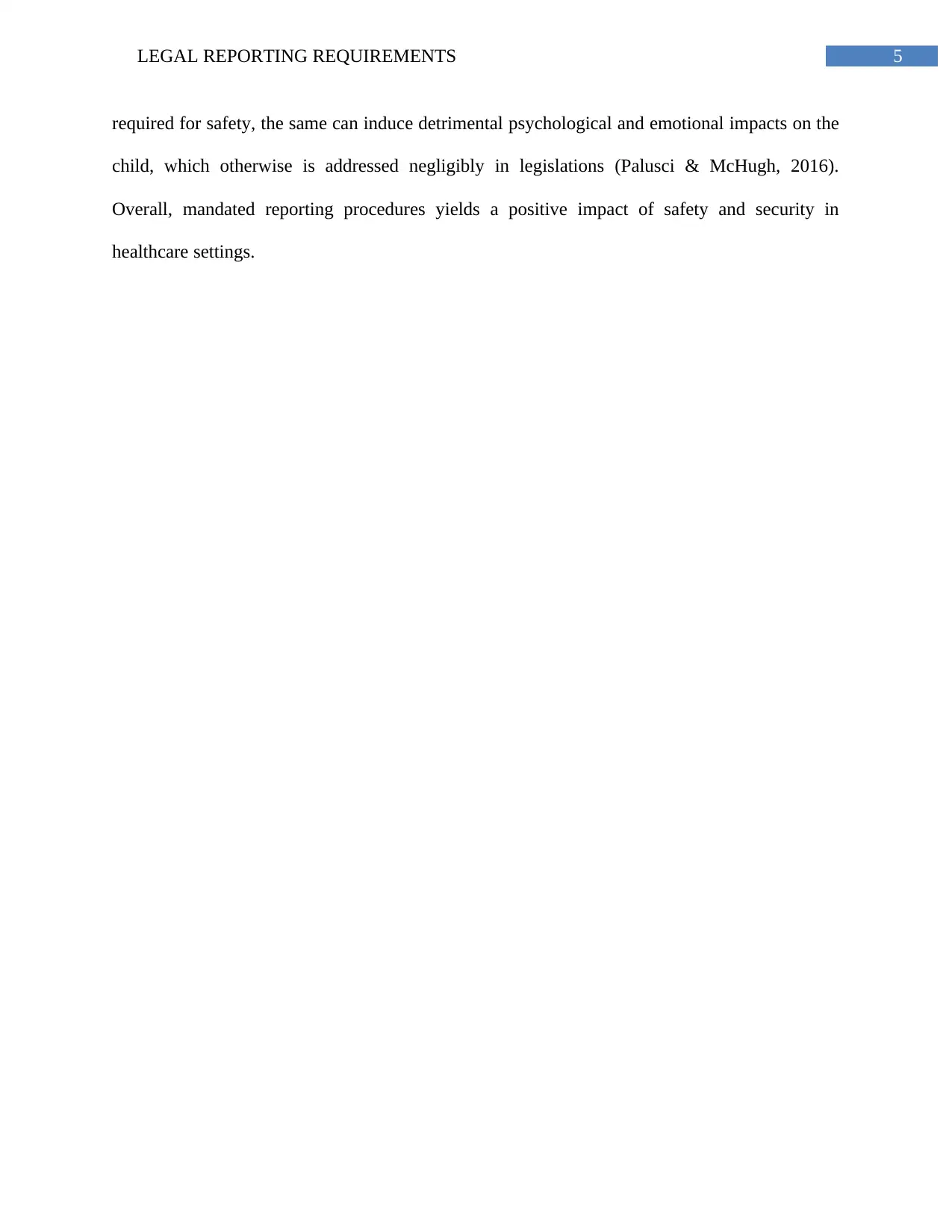
5LEGAL REPORTING REQUIREMENTS
required for safety, the same can induce detrimental psychological and emotional impacts on the
child, which otherwise is addressed negligibly in legislations (Palusci & McHugh, 2016).
Overall, mandated reporting procedures yields a positive impact of safety and security in
healthcare settings.
required for safety, the same can induce detrimental psychological and emotional impacts on the
child, which otherwise is addressed negligibly in legislations (Palusci & McHugh, 2016).
Overall, mandated reporting procedures yields a positive impact of safety and security in
healthcare settings.

6LEGAL REPORTING REQUIREMENTS
References
Child Welfare Information Gateway. (2019). How to Report Suspected Child Maltreatment -
Child Welfare Information Gateway. Retrieved from
https://www.childwelfare.gov/topics/responding/reporting/how/.
Child Welfare Information Gateway. (2019). Mandatory Reporters of Child abuse and neglect.
Retrieved from https://www.childwelfare.gov/pubpdfs/manda.pdf.
Christian, C. W., & Committee on Child Abuse and Neglect. (2015). The evaluation of suspected
child physical abuse. Pediatrics, 135(5), e1337-e1354.
Dinehart, L., & Kenny, M. C. (2015). Knowledge of child abuse and reporting practices among
early care and education providers. Journal of Research in Childhood Education, 29(4),
429-443.
Lynne, E. G., Gifford, E. J., Evans, K. E., & Rosch, J. B. (2015). Barriers to Reporting Child
Maltreatment Do Emergency Medical Services Professionals Fully Understand Their
Role as Mandatory Reporters?. North Carolina medical journal, 76(1), 13-18.
Mathews, B., Lee, X. J., & Norman, R. E. (2016). Impact of a new mandatory reporting law on
reporting and identification of child sexual abuse: a seven year time trend analysis. Child
abuse & neglect, 56, 62-79.
McTavish, J. R., Kimber, M., Devries, K., Colombini, M., MacGregor, J. C., Wathen, C. N., ... &
MacMillan, H. L. (2017). Mandated reporters’ experiences with reporting child
maltreatment: a meta-synthesis of qualitative studies. BMJ open, 7(10), e013942.
References
Child Welfare Information Gateway. (2019). How to Report Suspected Child Maltreatment -
Child Welfare Information Gateway. Retrieved from
https://www.childwelfare.gov/topics/responding/reporting/how/.
Child Welfare Information Gateway. (2019). Mandatory Reporters of Child abuse and neglect.
Retrieved from https://www.childwelfare.gov/pubpdfs/manda.pdf.
Christian, C. W., & Committee on Child Abuse and Neglect. (2015). The evaluation of suspected
child physical abuse. Pediatrics, 135(5), e1337-e1354.
Dinehart, L., & Kenny, M. C. (2015). Knowledge of child abuse and reporting practices among
early care and education providers. Journal of Research in Childhood Education, 29(4),
429-443.
Lynne, E. G., Gifford, E. J., Evans, K. E., & Rosch, J. B. (2015). Barriers to Reporting Child
Maltreatment Do Emergency Medical Services Professionals Fully Understand Their
Role as Mandatory Reporters?. North Carolina medical journal, 76(1), 13-18.
Mathews, B., Lee, X. J., & Norman, R. E. (2016). Impact of a new mandatory reporting law on
reporting and identification of child sexual abuse: a seven year time trend analysis. Child
abuse & neglect, 56, 62-79.
McTavish, J. R., Kimber, M., Devries, K., Colombini, M., MacGregor, J. C., Wathen, C. N., ... &
MacMillan, H. L. (2017). Mandated reporters’ experiences with reporting child
maltreatment: a meta-synthesis of qualitative studies. BMJ open, 7(10), e013942.
Paraphrase This Document
Need a fresh take? Get an instant paraphrase of this document with our AI Paraphraser
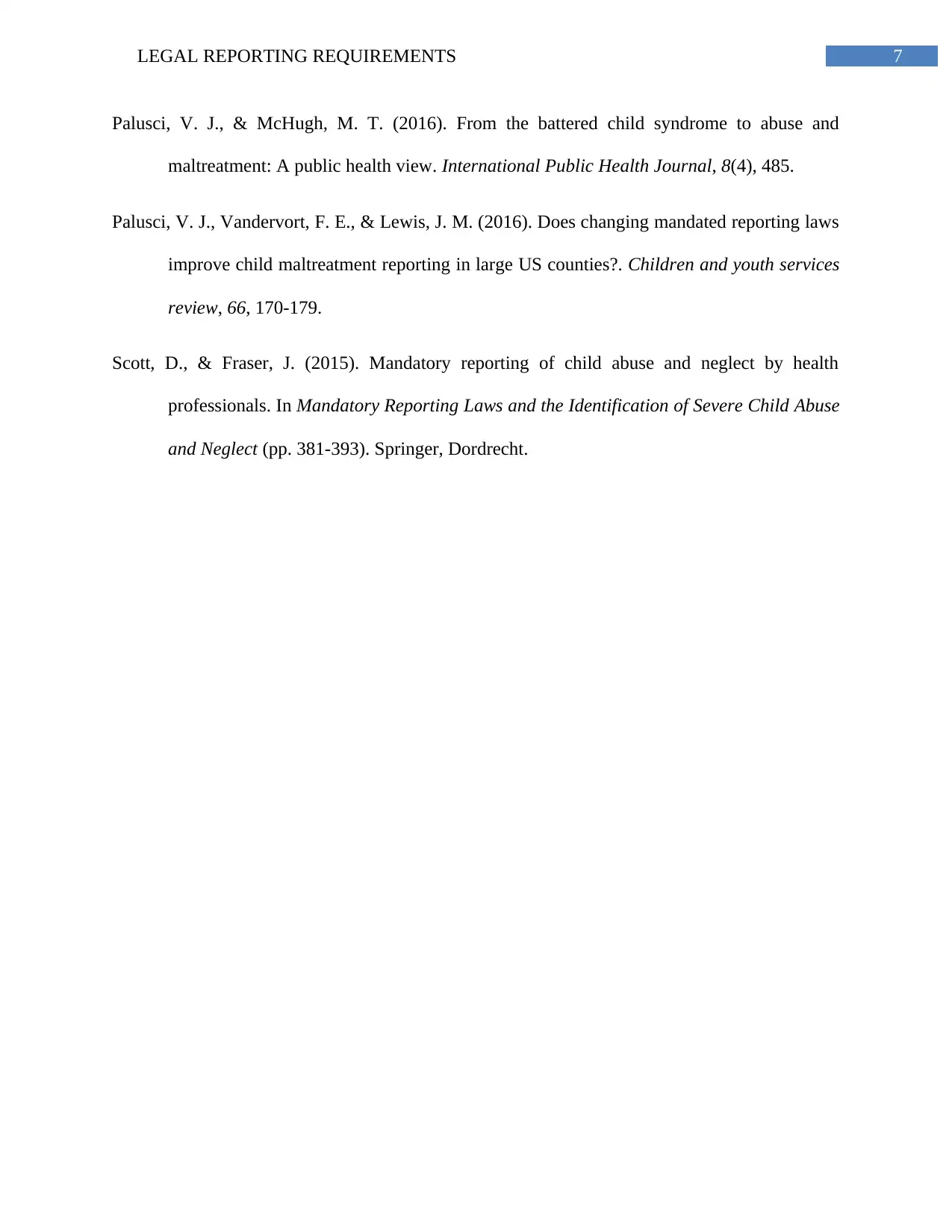
7LEGAL REPORTING REQUIREMENTS
Palusci, V. J., & McHugh, M. T. (2016). From the battered child syndrome to abuse and
maltreatment: A public health view. International Public Health Journal, 8(4), 485.
Palusci, V. J., Vandervort, F. E., & Lewis, J. M. (2016). Does changing mandated reporting laws
improve child maltreatment reporting in large US counties?. Children and youth services
review, 66, 170-179.
Scott, D., & Fraser, J. (2015). Mandatory reporting of child abuse and neglect by health
professionals. In Mandatory Reporting Laws and the Identification of Severe Child Abuse
and Neglect (pp. 381-393). Springer, Dordrecht.
Palusci, V. J., & McHugh, M. T. (2016). From the battered child syndrome to abuse and
maltreatment: A public health view. International Public Health Journal, 8(4), 485.
Palusci, V. J., Vandervort, F. E., & Lewis, J. M. (2016). Does changing mandated reporting laws
improve child maltreatment reporting in large US counties?. Children and youth services
review, 66, 170-179.
Scott, D., & Fraser, J. (2015). Mandatory reporting of child abuse and neglect by health
professionals. In Mandatory Reporting Laws and the Identification of Severe Child Abuse
and Neglect (pp. 381-393). Springer, Dordrecht.
1 out of 8
Related Documents
Your All-in-One AI-Powered Toolkit for Academic Success.
+13062052269
info@desklib.com
Available 24*7 on WhatsApp / Email
![[object Object]](/_next/static/media/star-bottom.7253800d.svg)
Unlock your academic potential
© 2024 | Zucol Services PVT LTD | All rights reserved.





